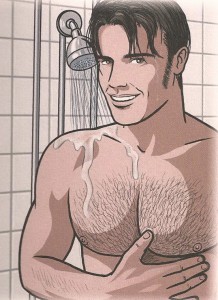Good Sports
Reviewed by Will Morgan 03-May-12
If you’ve ever wondered, “What would it look like if Mike Allred drew gay porn?”, the question’s very nearly answered with Good Sports…
PUCK THIS?
This is the fourth folio of filth from Dale Lazarov, a writer who has carved out his niche in what can most accurately be described, for want of a less clunky term, “romantic gay comics erotica”.
In his previous three books – Sticky, Manly, and Nightlife, each with a different artistic collaborator – Lazarov has adhered to a winning formula; short “silent” comics stories, in which his protagonists (trainer & pugilist, club bouncer & punk, and – a personal favourite – acoustic and electric guitarists!) “meet cute”, acknowledge their burgeoning attraction, and, well, fuck like bunnies.
A large part of the appeal of Lazarov’s work, to me, is the warmth, tenderness and humour he portrays alongside the sweating and spurting. Whether it’s a “relationship” or a one-night stand, the characters show affection and respect for each other. In this, he evokes one of the greater attractions of Tom of Finland’s work.
No, not the groiny endowments, which frankly over time became grotesque and scary, a trend followed by too many otherwise talented people working in this sub-genre (yes, I am looking at you, Patrick Fillion…). No, what I’m talking about are the facial expressions and body language that made Tom’s work more than just simple-minded fuckfests.
Lazarov’s previous work captured this quality, and it is doubly to his credit that he managed it with diverse artists and without benefit of dialogue or captions; “silent” scripts may look deceptively simple on the page, but having essayed a few myself, I can attest to how much harder you have to work to get your points made without the verbal component.

If you’ve ever wondered, “What would it be like if Mike Allred drew gay porn?” the question’s very nearly answered with Good Sports…
With Good Sports, Lazarov switches pattern slightly to one book-length story, rather than a collection of vignettes. Our heroes are hockey players – not that that’s relevant to the narrative, but it is an interesting step away from the usual highly-fetishised sports such as football, American football, rugby and the like. It switchbacks between their present and an unspecified past, which may or may not be their first meeting, which may or may not have taken place the previous evening, or some time ago. There is an unfortunate lack of clarity, and the attempt to use the added length of the story to deepen the relationship actually only muddles it, in this reader’s eyes. Not irreparably, by any means, but certainly distractingly.
Lazarov’s collaborator on Good Sports, Alessio Slonimsky, has technically the prettiest, most attractive style of his artists so far. Thick-lined, bold, cartoony, it put me heavily in mind – readers of a riper vintage will understand the reference – of those highly-polished graphics that were everywhere in the 1980’s after Duran Duran first hit big with Rio.
Trouble is, while it’s lovely to look at, Slonimsky’s work doesn’t convey the emotional range I’ve come to expect from Lazarov’s narratives; his faces are vaguely happy, vaguely moody, not-at-all-vaguely orgasmic – and that’s it. The bodies are striking, but you don’t engage with the personalities, because they’re not evident. It’s android sex.
However, if Good Sports isn’t quite up to Lazarov’s previous standard, that’s still a high standard from which to take a small step down. We’re talking about a book whose primary raison d’etre is to be read one-handed, and if that’s all you’re after, this is a superior example of the type.
Tags: Alessio Slonimsky, Bruno Gmunder, Dale Lazarov, gay comics
